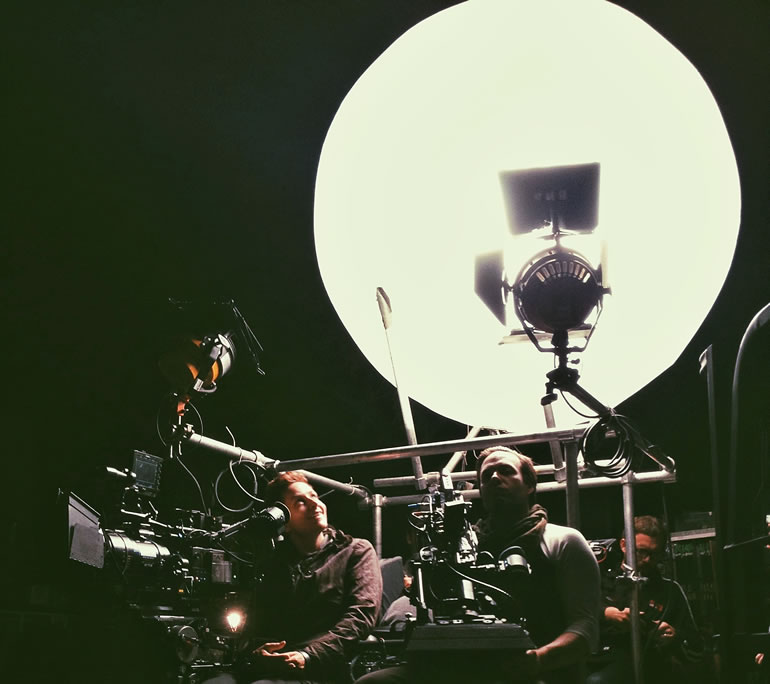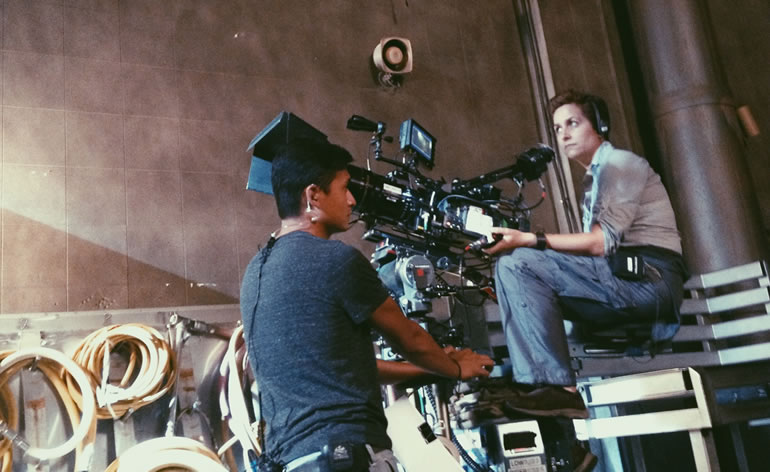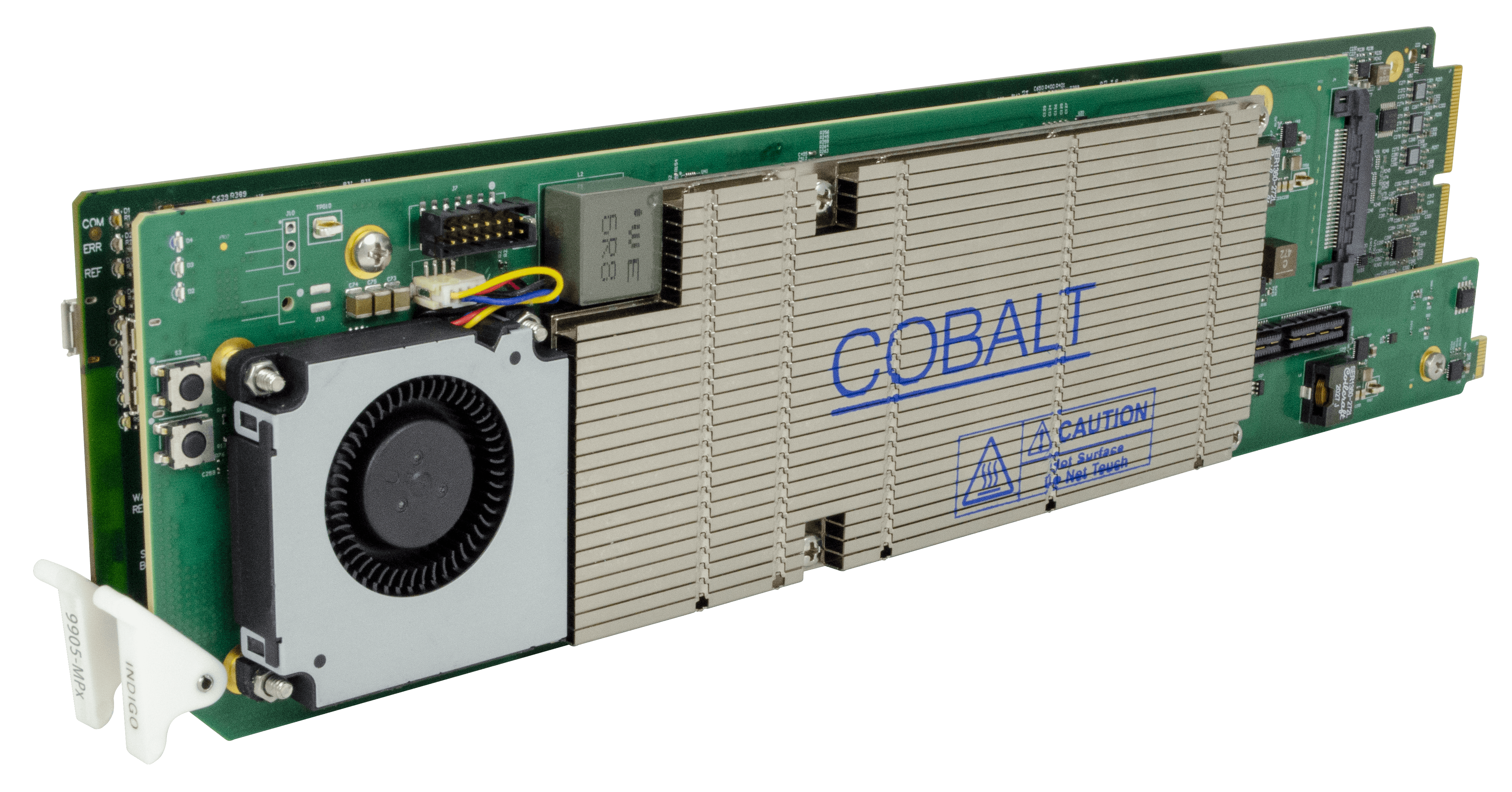Pictured above: Uta Briesewitz, ASC on the set of “Freaks of Nature.” Photo credit: Tyson Lindo.
A Conversation with Uta Briesewitz, ASC
Episodics and Features
Exclusive interview conducted by HDPROGUIDE
HDPROGUIDE: Your career as a cinematographer includes a wonderfully diverse body of work. What are some of the differences between filming styles for feature films, TV movies, episodics, and documentaries?
Uta Briesewitz, ASC: In feature films for theatrical release you can live more in wide shots since the big screen of a movie theatre allows the audience to discover things in the frame; even small details. You can see several actors in a wide shot and make your own decision who to look at, and it might not always be the person who delivers the line. Still, the image is large enough that you can clearly read performances even when seeing people from a distance. TV has very much been regarded as a writer’s medium where editing strongly guided you where to look. Many shows have been ruled by the spoken word, meaning visually the show lived in close ups of actors and a DP or director had to make sure to capture every line on camera. The world around those characters very often fell away. Maybe a quick establishing shot at the beginning of a scene… That was it.
But television has changed tremendously over the last decade. Bigger TV screens with a 16:9 aspect ratio didn’t only make the framing and composition of shots way more interesting for cinematographers, the increase in size of the screen also supports wide shots without losing details. All that plus the higher resolution allows DP’s to photograph their TV shows with a big screen in mind.
There is an incredibly vast variety of TV shows out now; anything goes.
Computer generated images have become such a huge part of our TV storytelling these days, that certain TV shows look like big budget features and several years ago those shows would have only been created for the big screen, e.g. Game of Thrones, Black Sails, Vikings and an endless list of superhero shows…
TV has become an amazing creative playground because of new outlets like Netflix, Amazon, Hulu… and simply because of the budgets that are being made available to produce shows. Features have always been regarded as the higher standard, the superior creative outlet. With the wide range of TV shows we have these days, that separation doesn’t necessarily hold up anymore.
HDPROGUIDE: What was one of your most favorite or memorable scenes to light, and why? Could you share with us your process and the lighting techniques you implemented?
Uta Briesewitz, ASC: Most of my films are based in a reality and by that I mean they take place at existing locations and not some far away galaxy. Therefore my lighting style usually comes from a very natural approach. As a DP I constantly observe light, how it moves, how it changes, how it differs from one city or country to the next. What makes places unique, where do you find interesting lighting? You steal with your eyes and then put your own personal twist on things. It’s a never-ending study and self education.
When I worked on the HBO series The Wire, I observed how Baltimore at night is bathed in an orange sodium vapor glow. It was important to me that the show looked truthful to the real environment. Back then you could get notes from producers or studios that they wanted clean (white) light on actors faces and producers felt distracted when faces were lit with colorful light. (I think some shows still apply that rule.) It helped to have been working for HBO where you are given incredible creative freedom. And being backed by executive producer Robert Colesberry allowed me to follow my vision for The Wire.
The most rewarding part of working on a show like The Wire was to immerse myself into an environment that otherwise I would have never gotten to experience. It was an unbelievable insight into a world that was very foreign to me but educated and affected me in a way that it will stay with me forever. I’m very grateful for that experience.
Jake Kasdan hired me to shoot my first studio feature, Walk Hard. Needless to say, with a bigger budget movie comes more time, more equipment, bigger sets, bigger crews, more toys,… just more of everything. The tight shooting schedules of indie movies and episodic TV are always a challenge. Experiencing the more generous shooting schedule on a studio feature is a real treat. Jake encouraged me to light the film like one of the many music bio pics that had come out in previous years and not light it like a bright comedy. Walk Hard took us through several time periods. One day we were shooting a black night club in the 50’s with 100 extras dancing passionately and the next day we were shooting John C. Reilly performing as Dewey Cox in an old theatre in downtown LA with 200 extras in gorgeous costumes from that era. In moments like that I always try to take a step back and take in the illusions we get to create. I always feel a huge amount of admiration for all the incredible work the other departments do. It’s a privilege to be the one who gets to photograph it all.
Shooting Session 9 for director Brad Anderson was not only a great technical exploration in shooting one of the first HD features to get a theatrical release, but also discovering the abandoned Danvers Mental Hospital for several weeks. One day while Brad and I were scouting the empty buildings that belonged to the hospital, we found a room covered in patient’s files. We just picked some up and started reading. The stories that were revealed to us were shocking, surprising and deeply moving. Those rooms and buildings were just filled with stories. Working with a limited budget, I would observe how the sun was moving through those buildings and when it would hit what room and what windows at what time of the day. (This was before iPhone apps that show you the exact path of the sun.) We needed that kind of prep to reflect it in our shooting schedule since some of the locations were simply too big for us to light; or the sunbeams falling through the open windows would have been impossible for us to recreate. Nothing beats the beauty of natural light.
One day on Session 9, we had already broken for lunch, a dramatic sky formed above us. Brad and I looked at each other and we both said, “We gotta shoot this”. Brad got David Caruso up on the roof with us and he improvised the little scene of David smoking a joint and saying, “It’s gonna get ugly”. The smaller scale of indie movies allows you to move quickly in moments like that. Feature studios are a way bigger machine to move. But if there is something incredible happening that you can’t recreate it’s always worth trying to capture it. Big or small.
HDPROGUIDE: Your filmography includes directing for episodics including “Fear the Walking Dead,” “The 100,” and “Orange Is the New Black,” to name a few. What would you say are major advantages for productions having a director with a high-level background and expertise in cinematography?
Uta Briesewitz, ASC: Being a director with an extensive background in cinematography is a great tool to bring with you. As a DP my job is to assist the director in the visual breakdown of a scene. I have shot several TV series where I had no time to prep because you simply don’t get to leave the set once the machine of a TV show starts rolling. So my job was to pitch ideas to the director on how to shoot a scene that had just been staged in front of me or possibly change the blocking to achieve certain shots or be more proficient with the camera set up count. Those pitches had to happen on the spot, there was no prep for it. No shotlisting or storyboarding.
As a result of that training I can find the blocking of a scene with the actors very quickly as a director. I can call out camera positions and lenses quickly, give directions on what the dolly or crane move and position needs to be. If there is a technical question that needs solving I can pitch ideas to be part of the solution. I can suggest a shooting approach that makes things achievable in the time restrictions or budget restrictions given since I know what it entails on the technical side.
The technical aspect of filming is not overwhelming to me. That’s where I actually feel at home. I always have it in mind. I can relate to the crew and especially to the DP, the things he or she needs to make his or her job easier. Sometimes it can just be asking the 1st AD to move a scene in the schedule so we will have the perfect sun position to shoot it in. Since it is easy for me to move that technical machine as a director, it allows me to focus on the actors and their performances which are crucially important to me. I believe that only a good performance makes a good image.
HDPROGUIDE: If you could share three lighting tips for filmmakers, videographers, and storytellers around the world, what would they be?
Uta Briesewitz, ASC: Watch the world around you, get inspired by it. Memorize these moments when you see “light happening”, and even when it’s just standing in line at a coffee shop and you watch the sun kicking off the windshields of the driving cars outside and those light kicks dance around on the wall behind the barista.
Whenever I recreated such a moment with rotating mirrors outside a restaurant the producer would usually come up to me all concerned and ask, “What is this?” And my answer would be, “This is natural light, this really happens. Just watch for it next time you get a coffee.”
Lighting does not only mean knowing what lights to set up and turn on but which ones to turn off.
I often found myself walking up on a set and turning lights off. Turning them off took me to where I wanted to be.
Just because a light is on when you work on a certain location, doesn’t mean it has to stay on.
Don’t fall into patterns of doing the same thing over and over but let the location and the script inspire you.
Change things up. Be open to doing things differently than you usually do them.
Really look at your subjects. What brings out their characteristics in their faces? What looks good, what looks bad? What supports the story, the emotional moment of the scene?
I was shooting an exterior on Hung and we brought in a light grid to diffuse the harsh sunlight on our actor’s face.
Once the diffusion went in front of the sun I realized that Thomas Jane actually looked way better without any diffusion.
His facial features were carved out by the harsh sunlight and the harsh shadows it created. The best light for him seemed to be the light that DP’s usually like to avoid for daytime exteriors: High noon.
Look… Don’t just assume and follow a formula.
 Pictured: Uta Briesewitz (left), BJ McDonnell (right, operator).
Pictured: Uta Briesewitz (left), BJ McDonnell (right, operator).




